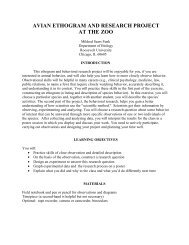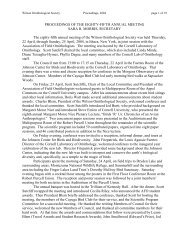Available now - Wilson Ornithological Society
Available now - Wilson Ornithological Society
Available now - Wilson Ornithological Society
Create successful ePaper yourself
Turn your PDF publications into a flip-book with our unique Google optimized e-Paper software.
WOS 2010 ~ ABSTRACTS p. 24<br />
information in one place for use by investigators and IACUCs will ensure that research protocols foster the humane<br />
handling of wild birds in research, while keeping research moving forward without hindrances that are not<br />
biologically warranted.<br />
36 The elements of science-based, adaptive bird conservation and the public trust doctrine. Charles R. Smith, Dept.<br />
Natural Resources, Cornell Univ., Ithaca, NY 14853-3001.<br />
As we approach the centennial of the Migratory Bird Treat Act (1918), it seems timely to consider modern,<br />
American bird conservation efforts in the contexts of science-based conservation, adaptive resource management,<br />
and the Public Trust Doctrine. In 1993, the U.S. Supreme Court established the Daubert Standard for assessing<br />
"good science." In 2008 the U.S. Dept. the Interior formally adopted adaptive resource management to guide its<br />
activities. Peer review is a key element of the Daubert Standard and adaptive resource management identifies a<br />
mechanism for accountability based upon progress toward measurable goals and objectives. The Public Trust<br />
Doctrine asserts that wildlife resources are held in trust for the Public by state and federal conservation agencies.<br />
Modern, populist bird conservation efforts and nongovernmental organizations (NGOs), however, have been slow to<br />
embrace the Daubert Standard and adaptive approaches to conservation. In particular, the popular mantra, "Birds are<br />
a lot like ducks," (a vague reference to the North American Waterfowl Management Plan by Partners in Flight) is<br />
misguided and uninformed. In addition, NGOs that accept money for memberships, asserting through advertising<br />
that they are achieving bird conservation, without showing progress toward measurable conservation goals and<br />
objectives (faith-based conservation), may be committing fraud. I contend that modern bird conservation would<br />
benefit from greater attention being given to conservation-by-demonstration (adaptive, science-based conservation)<br />
by both NGOs and state agencies. For state agencies, in particular, a failure to do so could be construed to be a<br />
violation of the Public Trust Doctrine.<br />
37 Variation in chickadee morphology through time in a moving hybrid zone. Robert L. Curry, Dept. Biology,<br />
Villanova Univ., Villanova, PA 19085<br />
Geographically shifting hybrid zones, while rarely detected and investigated, provide excellent opportunities to<br />
investigate the dynamics of interbreeding. I used data spanning 11 years from four southeastern Pennsylvania sites<br />
to examine the degree to which morphology has shifted in concert with genetic changes among hybridizing Carolina<br />
Chickadees (Poecile carolinensis) and Black-capped Chickadees (P. atricapillus). Field study and genetic analyses<br />
have shown that to date Carolina and Black-capped chickadees occur exclusively at Great Marsh and Tuscarora<br />
State Park respectively (80 km apart). Breeders in the geographically interjacent Nolde Forest population—which<br />
comprises predominantly hybrids—exhibit intermediate, but variable, size and shape measurements, with annual<br />
averages that have become indistinguishable from those of Carolina Chickadees at Great Marsh. Morphology of<br />
resident chickadees at Hawk Mountain overlaps with that of Black-capped Chickadees at Tuscarora, but shifts in<br />
measurements at Hawk Mountain toward Carolina values are evident, coincident with increases in the percentage of<br />
hybrids in that population; large variation among annual averages at Hawk Mountain, however, has complicated the<br />
pattern over time. Causes of the northward shift of this hybrid zone remain undetermined and genetic structure is<br />
complex, but morphological evidence in general supports rapid movement of the zone.<br />
38 Analysis of nest sites of the Resplendent Quetzal (Paromachrus mocinno): a relationship between nest and snag<br />
heights. Dennis G. Siegfried, Daniel S. Linville, and David Hille, Dept. Biology, Southern Nazarene Univ.,<br />
Bethany, OK 73008<br />
Secondary cavity nesters face many challenges in finding suitable nesting sites. One such species in the tropics, the<br />
Resplendent Quetzal (Pharomachrus mocinno), is of particular conservation concern because of its iconic status in<br />
Central American culture. As secondary cavity nesters, the Resplendent Quetzal modifies abandoned woodpecker<br />
nest sites located in dead tree trunks (i.e. snags). We used 11 historical nest sites, reported in 1969, from Atitlan,<br />
Guatemala and 10 recent nest sites from San Gerardo de Dota, Costa Rica to determine if any relationship exists<br />
between nest and snag height. We found that there were significant differences between Costa Rica and Guatemala<br />
in both nest height (6.3 m and 10 m respectively; t14 = -2.49, P = 0.042) and snag height (8.1 m and 14.0 m<br />
respectively; t13 = -2.39, P = 0.033). We found no difference in nest heights relative to snag heights for Costa Rica<br />
(0.76) and Guatemala (0.77; t17 = -0.20, P = 0.84). One aspect of conservation efforts for this species has been the<br />
placement of nest boxes to provide nesting sites for additional pairs. Based on our results, we <strong>now</strong> have a better<br />
understanding of the necessary placement requirements of these boxes to ensure use regardless of where within the<br />
species range they are used.<br />
39 Influences of mate quality and population growth on House Wren clutch size. Lindsey A. Walters, Dept.<br />
Biology, Canisius College, Buffalo, NY 14208, Natalie Dubois and Thomas Getty, Dept. Zoology and Kellogg<br />
Biological Station, Michigan State Univ., Hickory Corners, MI 49060





